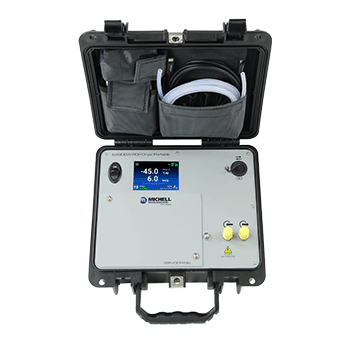Why is it important to monitor the dew point of air or other gases under pressure?
The main reason to measure the dew point of gas under pressure is to avoid the risk of condensation forming in the system, which can lead to bacterial growth or corrosion of valves. Condensation becomes a risk when gas is pressurized because the dew point of air or gas rises with pressure. This makes drying the air especially crucial and monitoring the dew point of the dry gas not only helps control drying cost but also provides quality checks on the high-pressure air or gas. Our article ‘How to calculate pressure dew points (PDP) accurately’ explains the physics that causes this.
What are the main applications where you would need to measure dew point at pressures over 100 barg?
In industrial applications, pressures from 20 to 450 barg (290 to 6527 psig) are referred to as ‘ultra-high pressures’. Typical applications for ultra-high-pressure air include:
Read more about the critical measurements in breathing air.
Avoiding excess moisture is vital in marine applications because of the risk of freezing. Reducing the pressure of a gas has a cooling effect, and this, coupled with the already low temperatures below sea, could easily lead to ice forming in air lines and disable the submarine.
Why ceramic metal oxide moisture sensors are recommended for measuring dew point in high pressure air or gas
Metal oxide moisture sensors directly measure the partial pressure of water vapor. For any given partial pressure of water vapour there is only one corresponding dew point. This means that as the partial pressure of water vapour increases with total pressure, the measurement performance remains valid and directly related to its factory calibration.
The Michell Ceramic Metal Oxide moisture sensor has been designed with high-pressure applications in mind, providing excellent performance when compared to the performance of alternative polymer-sensor products.
What are the options for measuring trace moisture in ultra-high-pressure gas?
In-line measurements.
The sensor is placed directly in the gas line and measures at line pressure.
Spot checks using a portable hygrometer.
Extractive sampling.
A sample of gas is removed from the system and moisture is measured at a lower pressure.
Recommended products
We have a wide choice of dew-point transmitters and portable hygrometers that are capable of measuring dew point and trace moisture in gases at various pressures.
Measure trace moisture in pressures from 100 barg/1450 psig up to 138 barg/2002 psig
SF82 | Dew Point Control | Compressed Air Dryers (processsensing.com) - 100 barg/1450 psig

Compressed Gas Dew-Point Meter - Easidew PDP Dryer Portable 20 barg/290 psig
Process Moisture Analyzer - Michell Promet EExd (processsensing.com) - 30 to 138 barg /435 to 2002 psig
Moisture in Natural Gas Analyzer - Michell OptiPEAK TDL600 (processsensing.com) - inlet pressure max 100 barg/1450 psig
Hydrocarbon Dew-Point Analyzer | Automatic On-line Analysis (processsensing.com) for water dew point at 138 barg/2002 psig
Measure trace moisture at pressures up to 350 barg

|

|
Portable Dew-Point Hygrometer - Michell MDM300 Series (processsensing.com) 350 barg/5076 psig With optional sampling system
Measure trace moisture at pressures up to 450 barg/6527 psig:

Michell Easidew EA2 | Moisture Meter (processsensing.com) - up to 450 barg/6527 psig For in-line measurements in ultra-high-pressure air. A hazardous area version is available for measurements in flammable gases, such as natural gas or biomethane.
Process Moisture Analyzer - Michell Promet I.S (processsensing.com) up to 450 barg/6527 psig A complete sampling system for measurements in natural gas or other flammable gases.
Measure trace moisture in air or gas up to 900 barg/10,153 psig
Moisture measurements in these pressures are possible with the Michell Ceramic Metal Oxide Moisture Sensor and Michell Easidew Dew-Point Transmitters range. Contact us to get expert advice for your project.
Related Products
Dew-Point Transmitter for Compressed Air Dryers - SF82
Compressed Gas Dew Point Meter - Easidew PDP
Dryer Portable
Process Moisture Analyzer - Michell Promet EExd
Hydrocarbon Dew-Point Analyzer - Michell Condumax II
Portable Dew-Point Hygrometer - Michell MDM300 Series
MDM300 Sampling Options
Dew-Point Transmitter - Michell Easidew EA2
Process Moisture Analyzer - Michell Promet I.S
Bluetooth Water Activity Measurement Head - Rotronic AwEasy
Want to see more information like this?
Sign up to one of our Industry newsletters and you’ll receive our most-recent related news and insights all directly to your inbox!
Sign Up